Leaving Australia
 Friday, October 10, 2008 at 4:36PM
Friday, October 10, 2008 at 4:36PM Welcome to our travelogue, a quick way to keep family and friends up to date on our life in Basel. We hope to add posts here regularly. If you like you can subscribe via RSS . Please read whenever and whatever takes your fancy. However, we’d prefer if you did not create public links to this site, nor send the address to other people without asking us first. If you’ve arrived here without invitation, then we hope you’ll respect our privacy.
Since leaving Australia in August, we’ve been rather busy carting ourselves around the planet, with no time for much email, let alone blogging. However, a travelogue is supposed to be chronological, so we’ll start back in Sydney, and catch up over time. But just so you know, we are now living in a temporary furnished apartment in Basel in the Stegreif Mill, one of the buildings that houses the Swiss Paper Museum. Life is proceeding essentially as planned, although everything seems to take longer than expected here. We’ll also intersperse, amongst the travelogue entries, photos of the many fountains, statues, medieval buildings and other civil decorations that adorn Basel and give it such charm.
Our last night at home in Sydney was August 1st. After weeks of planning and sorting, the removalists had come and packed the majority of our possessions into a somewhat battered-looking container. 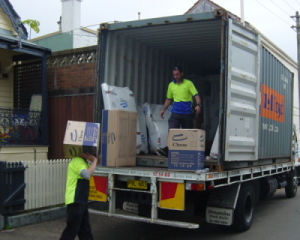 The house was empty, apart from a borrowed air mattress and the yet-to-be-packed flight luggage. The boys ran from room to room delighted by the echoes of their own shouts. In the morning, we packed, finished cleaning up the house and made some final arrangements. Then we set off to Bondi Junction to stay two nights in the Meriton Apartments, our ‘neues Haus’ (new house) as the twins called it. They were quite excited to find that it was built on top of a bus terminal — if you happened to be so inclined you could sit by the huge circular window in the living room and look down on an endless stream of buses and taxis going in and out. For mysterious reasons, the adults preferred to ignore this and instead look outwards to the eastern beaches and the ocean. Either way, it was good to be underway after months of concerted preparations.
The house was empty, apart from a borrowed air mattress and the yet-to-be-packed flight luggage. The boys ran from room to room delighted by the echoes of their own shouts. In the morning, we packed, finished cleaning up the house and made some final arrangements. Then we set off to Bondi Junction to stay two nights in the Meriton Apartments, our ‘neues Haus’ (new house) as the twins called it. They were quite excited to find that it was built on top of a bus terminal — if you happened to be so inclined you could sit by the huge circular window in the living room and look down on an endless stream of buses and taxis going in and out. For mysterious reasons, the adults preferred to ignore this and instead look outwards to the eastern beaches and the ocean. Either way, it was good to be underway after months of concerted preparations.
The apartment building also had a heated swimming pool and spa, so adorned with floaties we went down through the foyer to check it out. This proved to be a wonderful idea. The twins had not been swimming since March, and more exposure to the water was long overdue. Wiki was delighted to discover that he could now paddle short distances over deep water, and Loxon’s traditional reticence at all things containing more liquid than himself was firmly shaken at seeing how much fun Wiki was having. This was to prove a perfect preparation for swimming experiences in Singapore, Mannheim and Basel over the next month.
As if to emphasise what we were soon to give up, Sydney turned out a beautiful sunny Sunday, in which we walked down to Centennial Park to see the black swans proudly drifting along the lake shore (and, of course, to chase some moorhens around — after all they could probably do with the exercise). On Monday, Opa (Grandpa) Chris drove us out to the airport for the flight to Singapore. There was no space left in the car, but Tante (Aunt) Marina made her own way there separately to see us off. We arrived at check-in, proud of our immensely complex packing plan. All our non-carry-on luggage, including cots, child carriers and toys for two months, was carefully arranged into four check-in items, each not heavier than 32kg, and neatly separable into those we needed in Singapore and those we could check through to Frankfurt. We had even called the airline in advance to confirm that this was allowed. We placed our luggage onto the conveyor, and smiled to ourselves as it agreed that our heaviest item was only 31.8kg. For a moment, we savoured the satisfaction, until a few seconds later the check-in agent explained that items of luggage could only be checked through to Frankfurt if our stay in Singapore was 48 hours or less. Our stopover there was 56 hours. It would have been so much easier to pack if we had known this in advance; and now we would have to deal with all our luggage in Singapore. Would we be able to find a taxi with around two cubic metres of luggage space at close to midnight in Singapore Airport? It looked like we would soon find out.
After a quick lunch of risotto (life is so much easier these days with the microwaves in parents’ rooms), we waved goodbye to Opa Chris and Tante Marina, passed through immigration and went to watch the planes landing and taking off. They’re much the same as buses, but they go up and down instead of in and out, and even parents seem interested in watching them.
When it was time, we went to check out our plane, an A380. ‘That is a grosses Flugzeug (big plane)’ remarked Loxon, showing not only his ability to speak two languages at once, but also astute awareness of modern aircraft designs. We walked past the largest queue I’ve ever seen waiting to board a plane, and stepped into business class. But describing that can wait until the next post.
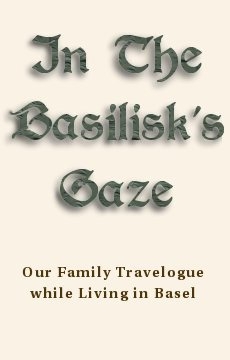
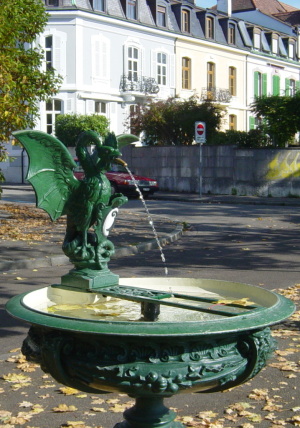 The design, by Wilhelm Bubeck, won a competition in 1884, held to choose the footpath fountains for the city. This fellow
The design, by Wilhelm Bubeck, won a competition in 1884, held to choose the footpath fountains for the city. This fellow 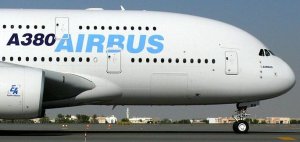
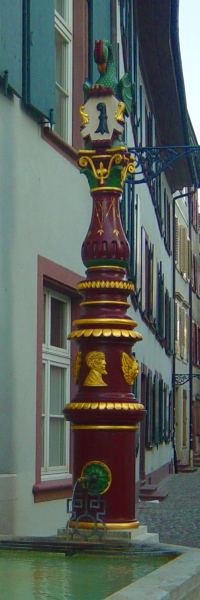 The present form was created in 1530, although at that time it stood at the centre of the intersection. In 1846, it was moved to the side, where it still stands.
The present form was created in 1530, although at that time it stood at the centre of the intersection. In 1846, it was moved to the side, where it still stands.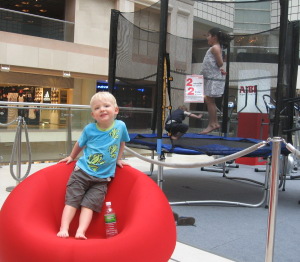
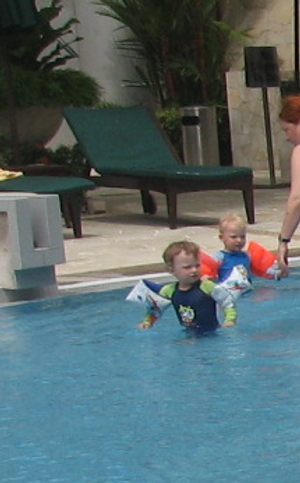 Wiki, spurred on by a Dutch boy, even experimented with leaping into the pool from the side, which Yan managed to
Wiki, spurred on by a Dutch boy, even experimented with leaping into the pool from the side, which Yan managed to 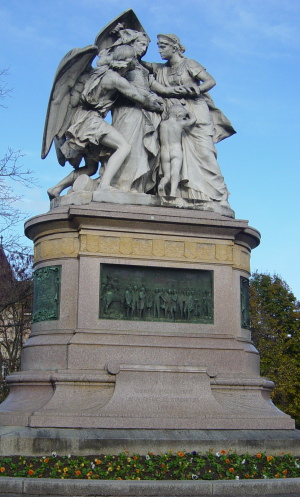 It was designed by
It was designed by 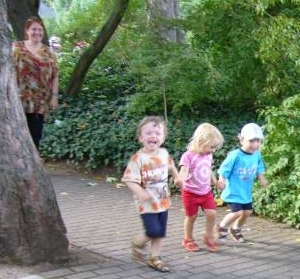 From Lea’s point of view, things were even better: she had twin blonde cousins!
From Lea’s point of view, things were even better: she had twin blonde cousins!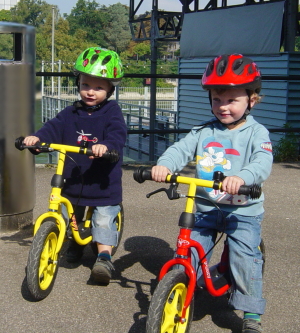 Within minutes, Loxon and Wiki were bouncing their way along the beachfront, crashing every few metres as they tried to keep up with Lea. When they finally tired of the bumps and bruises, they tried their hands at skimming stones on the river (that was when we realised that our container would have to pass this
Within minutes, Loxon and Wiki were bouncing their way along the beachfront, crashing every few metres as they tried to keep up with Lea. When they finally tired of the bumps and bruises, they tried their hands at skimming stones on the river (that was when we realised that our container would have to pass this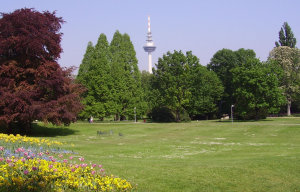 From the exotic butterfly enclosure to the gigantic climbing castle, from the chinese teahouse to the penguin pool, from the gondoletta on the lake to the peaceful meadow tucked in a quiet corner, it has something for everyone. For the travel-weary adults, just lying back and gazing over the broad swathes of soft green grass felt like paradise. The futuristic form of Mannheim’s television tower hovered on the horizon, hinting at a science-fiction utopia of perfectly controlled environments.
From the exotic butterfly enclosure to the gigantic climbing castle, from the chinese teahouse to the penguin pool, from the gondoletta on the lake to the peaceful meadow tucked in a quiet corner, it has something for everyone. For the travel-weary adults, just lying back and gazing over the broad swathes of soft green grass felt like paradise. The futuristic form of Mannheim’s television tower hovered on the horizon, hinting at a science-fiction utopia of perfectly controlled environments. 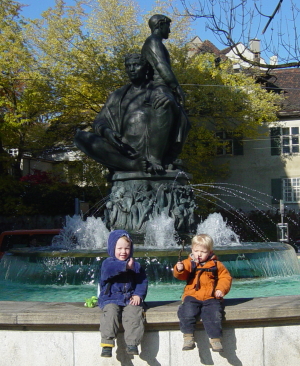 There he had earlier been a close colleague of
There he had earlier been a close colleague of 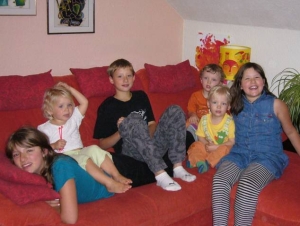 Wiki and Loxon’s other three cousins, Leonie and twins Olivia and Alexander, are a little older, but were just as excited to meet the boys. Our pediatrician back in Australia had told us that Marion’s brother having twins means Marion is also more likely to do so. And it is hard to argue given that the background twinning rate without fertility treatments is around 1 in 80 pregnancies. So far though only
Wiki and Loxon’s other three cousins, Leonie and twins Olivia and Alexander, are a little older, but were just as excited to meet the boys. Our pediatrician back in Australia had told us that Marion’s brother having twins means Marion is also more likely to do so. And it is hard to argue given that the background twinning rate without fertility treatments is around 1 in 80 pregnancies. So far though only 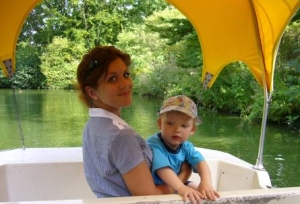 She gave the boys a puppet with which she had grown up, called
She gave the boys a puppet with which she had grown up, called 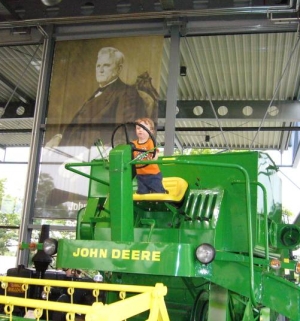 All these are crawlable over and through, but fortunately the keys had been removed from those in working order. Although I suppose watching a tractor bounce out through the glass walls with Loxon at the helm would have offered stunning, if short-lived, entertainment.
All these are crawlable over and through, but fortunately the keys had been removed from those in working order. Although I suppose watching a tractor bounce out through the glass walls with Loxon at the helm would have offered stunning, if short-lived, entertainment.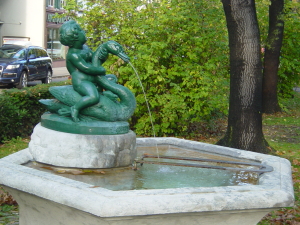 This fountain was cast by the Paravicinische Giesserei in 1864. It stands
This fountain was cast by the Paravicinische Giesserei in 1864. It stands 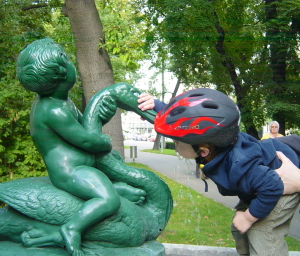 Naturally the fountains got regular use, especially given how much water Loxon needs to keep up his high energy lifestyle.
Naturally the fountains got regular use, especially given how much water Loxon needs to keep up his high energy lifestyle.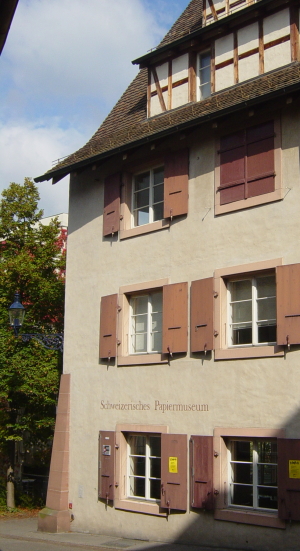 It had been advertised as having 4.5 rooms, and we had confirmed that it had two full bedrooms and a study. We also knew
It had been advertised as having 4.5 rooms, and we had confirmed that it had two full bedrooms and a study. We also knew  As is often the case in Basel, we could have paid in Euros, but Serge the waiter had already seen that we were moving in upstairs, and told us we should simply drop by the next day to pay. Already the Stegreif Mill was starting to feel like home.
As is often the case in Basel, we could have paid in Euros, but Serge the waiter had already seen that we were moving in upstairs, and told us we should simply drop by the next day to pay. Already the Stegreif Mill was starting to feel like home.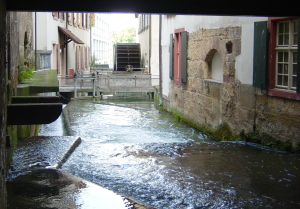 Since the city is relatively flat, this means cycling is usually the fastest way to get between any two points, unless there is a direct tram and you are lucky with your timing. Expecting a car to get you somewhere quickly is a recipe for frustration, which is the way it should be in such a compact, quirky city.
Since the city is relatively flat, this means cycling is usually the fastest way to get between any two points, unless there is a direct tram and you are lucky with your timing. Expecting a car to get you somewhere quickly is a recipe for frustration, which is the way it should be in such a compact, quirky city. Everywhere else we’ve lived, banks make it tricky for newly arrived immigrants to open an account. Not in Switzerland — not right now, at least. We rang the
Everywhere else we’ve lived, banks make it tricky for newly arrived immigrants to open an account. Not in Switzerland — not right now, at least. We rang the